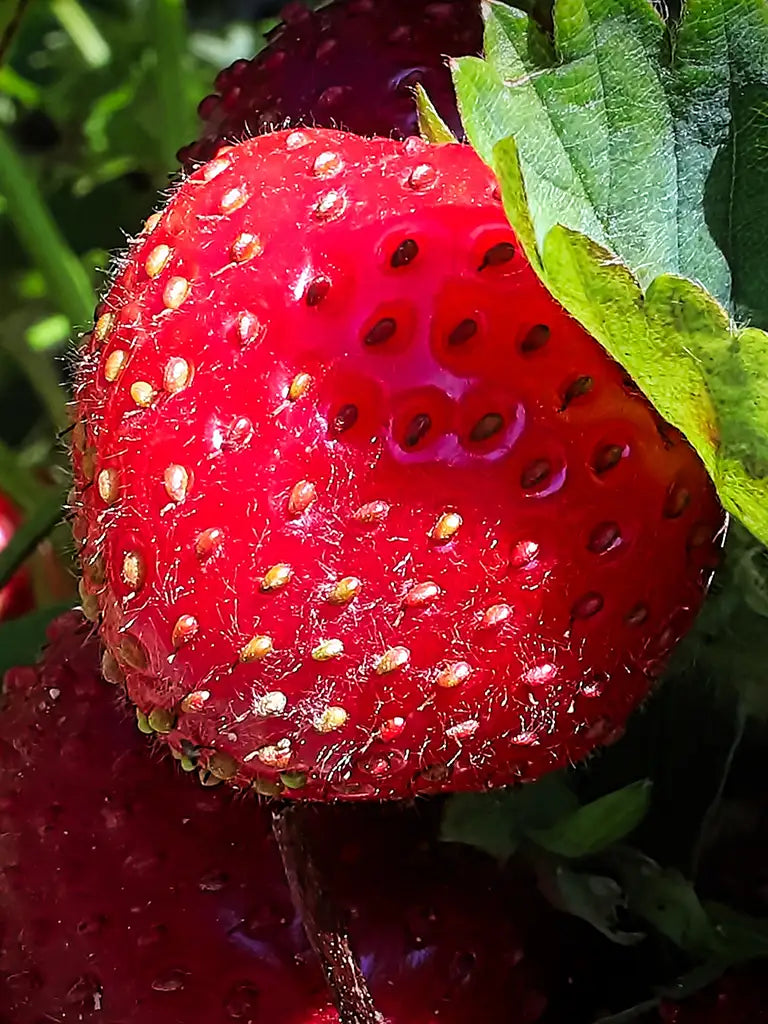Bloemoloog
Organic Fragaria ananassa 'Framberry' - Raspberry Strawberry | 3 pcs.
Organic Fragaria ananassa 'Framberry' - Raspberry Strawberry | 3 pcs.
Estimated Shipping Widget will be displayed here!
Couldn't load pickup availability
Organic raspberry strawberry
The Fragaria ananassa 'Framberry' is a cross between a strawberry and a raspberry, hence the name; 'raspberry strawberry'. The plant bears fruit in July and August. Suitable for garden, pot and hanging baskets. Particularly tasty and easy to grow strawberries yourself. The roots can remain outside during the winter, in the spring they will grow again.
Raspberry strawberries simply taste like strawberries and are deliciously sweet.
Attention! You are buying the roots (nuts) of this strawberry plant.
How, where and when do I plant strawberry cuttings in the ground?
Plant the roots of the strawberry plant in the ground immediately upon delivery. Plant the 'Framberry' in a place with plenty of sunlight. Strawberries thrive best in well-drained, fertile soil. Dig a hole of about 10 centimeters and spread the roots over the ground and fill the hole with soil. Let the new green shoots stick out just above the ground and give sufficient water.
Care
Provide good general care for the plant, including regular watering, removing weeds around the plant, and applying suitable fertilizers. This will contribute to the health and vitality of the strawberry plant.
Organic fertilizers, such as compost or well-rotted manure, can be used to feed strawberry plants. Not only do they add nutrients, but they also improve soil structure.
Protection against frost
If there is still a chance of frost after the first flowers have appeared, consider protective measures. Frost can damage the flowers and thus affect fruit formation. Cover the plants with cloths or garden fleece if frost is predicted.
Remove the first flowers
It is often beneficial to remove the first flowers from strawberry plants. This is also called "deflowering". By removing the first flowers, you direct the plant's energy to developing strong roots and healthy foliage instead of producing fruit. This helps the plant to grow stronger and produce a larger harvest in subsequent flowering periods.
While removing the first few flowers can be beneficial to the overall health of the plant, it is also important to leave some flowers. This allows the plant to reproduce and eventually produce fruit. Once the plant is well established, you can leave more flowers to encourage fruiting.
Pollination
Strawberries need pollination to produce fruit. If you find that there are few bees or other pollinating insects in your garden, consider gently dusting the flowers with a soft brush. By gently brushing the flowers, you will mimic the action of a pollinating insect and help the fruit to form.
Health Benefits
Strawberries are not only known for their delicious taste, but also for their health benefits. They are rich in vitamin C, antioxidants and dietary fiber, and are often considered a healthy addition to the diet.
History of the strawberry
Wild strawberries are native to many parts of the world, including North America, Europe, and Asia. People have gathered and eaten wild strawberries for centuries for their pleasant flavor and supposed health benefits.
Strawberry cultivation began in Europe in the 14th century. Initially, wild strawberries were gathered from forests and fields. However, European gardeners soon began selectively breeding strawberries to produce larger, sweeter fruits.
Strawberries gained royal recognition in the 14th century when they were planted in the gardens of the French royal court. King Charles V of France is often cited as an early strawberry lover.
In the 19th century, strawberry festivals became popular in the United States. These events, often held in the spring, marked the beginning of strawberry season and provided an opportunity for communities to come together and enjoy strawberries in various dishes.
Today, strawberries are one of the most popular and cultivated berries in the world. They are widely grown in various climates and are available year-round.
Buy organic Fragaria 'Framberry'
Skal NL-BIO-01 certified: 109459
Packed per 3 bare roots or choose a stacking discount.
Stacking discount: C
Can be ordered from January '26!
EU shipping €8.95 - Free Shipping from €100,- purchase.
Properties
| Flowering time: | July - August |
| Planting time: |
Spring |
| Planting depth: |
2 cm below ground |
| Planting distance: | 30 cm apart |
| Height: |
15 cm high |
| Flower diameter: |
3 cm wide |
| Location: |
Part shade, sun |
| Soil PH: | Loam, sandy soil - Slightly acidic/neutral |
| Winter hardiness: |
Not winter hardy |
| Propagation: | Good |
| Origin: | South America |
| Family: | Rosaceae (rose family) |
| Group: | Pineapple (raspberry strawberry) |
| Colour: | White (red fruit) |
| Bee friendly: | Yes |
| Fragrant: | No |
| Quality: | Undivided nuts |
NL-BIO-01
To share





